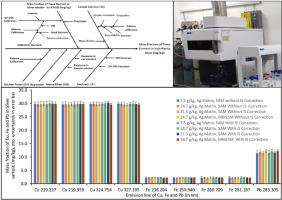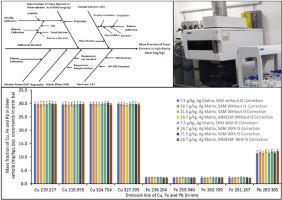ICP-OES分析高纯银微量元素的方法验证及不确定度评定
IF 6
2区 化学
Q1 CHEMISTRY, ANALYTICAL
引用次数: 0
摘要
银是一种贵金属,高纯度银广泛用于电子、光学和参考材料应用,即使微量的杂质也会严重影响性能和精度。由于潜在的基质效应和对精确校准策略的需求,在高纯度银中定量痕量元素,如Cu, Pb, Fe和其他元素提出了分析挑战。采用电感耦合等离子体发射光谱法(ICP-OES)对高纯银样品中的微量杂质Cu、Fe和Pb进行了定量分析,并对其结果进行了比较。该研究还包括与每种方法相关的综合不确定度评估。验证参数如LOD(检测限),LOQ(定量限),工作范围,准确度和精密度也在手稿中进行了详细的讨论。两种校准方法的结果具有可比性。两种方法都被发现有能力解释矩阵效应。结果的回收率表明,两种方法都能提供可靠的定量结果。双向方差分析结果表明,发射谱线和基质浓度对SAM和MMESM测定铜、铁和铅的结果具有统计学上的可比性。观察到两条额外的铜发射线和一条额外的铁发射线,并在此报告。同时,对经内标校正和不经内标校正的SAM和MMESM结果进行了定量分析,结果基本一致。因此,这项工作为银的微量元素分析提供了一个全面的认识,也可以推广到其他金属。本文章由计算机程序翻译,如有差异,请以英文原文为准。


Method validation and uncertainty evaluation in trace element analysis of high-purity silver by ICP-OES
Silver is a precious metal, and high-purity silver is widely used in electronic, optical, and reference material applications, where even trace amounts of impurities can critically impact performance and accuracy. Quantifying trace elements such as Cu, Pb, Fe, and others in high-purity silver poses analytical challenges due to the potential matrix effects and the need for accurate calibration strategies. The trace impurities, Cu, Fe, and Pb in high-purity silver samples were quantified using the standard addition (SAM) and the matrix-matched external standard method (MMESM) using inductively coupled plasma optical emission spectrometry (ICP-OES), and their results are compared. The research also includes a comprehensive uncertainty evaluation associated with each method. Validating parameters like LOD (Limit of Detection), LOQ (Limit of Quantification), working range, accuracy, and precision are also discussed in detail in the manuscript. The results obtained from both the calibration approaches were found to be comparable. Both methods were found to have the ability to account for the matrix effect. The recovery found for the results indicates that both methods provide reliable quantification. The two-way ANOVA results demonstrate that both emission lines and matrix concentrations yield statistically comparable results for copper, iron, and lead determination by SAM & MMESM. Two extra emission lines for copper and one for iron estimation were observed and are reported here. Also, the results for both SAM and MMESM with and without internal standard correction were quantified, and the results were almost the same. Thus, this work provides a comprehensive understanding of trace element analysis in silver, which can also be extended to other metals for trace element analysis.
求助全文
通过发布文献求助,成功后即可免费获取论文全文。
去求助
来源期刊

Analytica Chimica Acta
化学-分析化学
CiteScore
10.40
自引率
6.50%
发文量
1081
审稿时长
38 days
期刊介绍:
Analytica Chimica Acta has an open access mirror journal Analytica Chimica Acta: X, sharing the same aims and scope, editorial team, submission system and rigorous peer review.
Analytica Chimica Acta provides a forum for the rapid publication of original research, and critical, comprehensive reviews dealing with all aspects of fundamental and applied modern analytical chemistry. The journal welcomes the submission of research papers which report studies concerning the development of new and significant analytical methodologies. In determining the suitability of submitted articles for publication, particular scrutiny will be placed on the degree of novelty and impact of the research and the extent to which it adds to the existing body of knowledge in analytical chemistry.
 求助内容:
求助内容: 应助结果提醒方式:
应助结果提醒方式:


